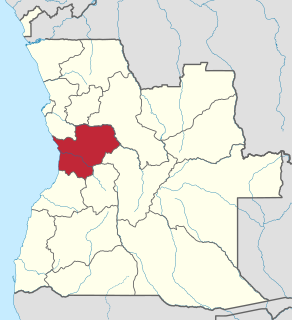
Cuanza Sul Province is a province of Angola. It has an area of 55,660 square kilometres (21,490 sq mi) and a population of 1,881,873. Sumbe is the capital of the province. Don Francisco Inocêncio de Sousa Coutinho founded the province in 1769 as Novo Redondo.

The Kwanza River, also known as the Coanza, the Quanza, and the Cuanza, is one of the longest rivers in Angola. It empties into the Atlantic Ocean just south of the national capital Luanda.

Sumbe, formerly Novo Redondo, is a city located in west central Angola. It is the administrative capital of Cuanza Sul Province. In 2014 its population was 279,968.

The Ambundu or Mbundu (Mbundu: Ambundu or Akwambundu, singular: Mumbundu are a Bantu people living in Angola's North-West, North of the river Kwanza. The Ambundu speak Kimbundu, and mostly also the official language of the country, Portuguese. They are the second biggest ethnic group in the country and make up 25% of the total population of Angola.
The precolonial history of Angola lasted until Portugal annexed the territory as a colony in 1655.
The colonial history of Angola is usually considered to run from the appearance of the Portuguese under Diogo Cão in 1482 (Congo) or 1484 until the independence of Angola in November 1975. Settlement did not begin until Novais's establishment of São Paulo de Loanda (Luanda) in 1575, however, and the Portuguese government only formally incorporated Angola as a colony in 1655 or on May 12, 1886.

The following outline is provided as an overview of and topical guide to Angola:
The Fortress of São Francisco do Penedo is located in the port city of Luanda, Angola, at coordinates 8°48′05″S13°15′01″E.
The Church of Our Lady of Victoria stands near the banks of the Cuanza River in Massanganu, Province of Kwanza-Norte, Angola.
The Fortress of Kambambe is a historic stronghold built by Portuguese colonialists on the east bank of the Cuanza River in Cambambe, Province of Cuanza Norte Province, Angola.
The Fortress of Muxima, built of stone and mortar in 1599, is situated in the Bengo Province of Angola next to the Cuanza River.
The Church of Our lady of Muxima is located in the Muxima District of Bengo Province, western Angola.
The Church of Nossa Senhora do Rosario is located in Kuanza Norte province, Angola.
The Portuguese colony of Angola was founded in 1575 with the arrival of Paulo Dias de Novais with a hundred families of colonists and four hundred soldiers. Luanda was granted the status of city in 1605. The fortified Portuguese towns of Luanda and Benguela.

Cela is a município (municipality) in the province of Cuanza Sul in Angola. It covers an area of 4,610 square kilometres (1,780 sq mi) and its population is 225,520 in 2014.
Coffee production in Angola refers to the production of coffee in Angola. Coffee is one of Angola's largest agricultural products; at its peak, while under Portuguese rule, Angola was the third-largest producer of coffee in the world.
The United Nations General Assembly declared the year 2011 as International Year for People of African Descent. That year also marked the 10th anniversary of the World Conference Against Racism, which approved a resolution stating that slavery along with the colonization that sustained it were crimes against humanity.
Atlético Futebol Polivalente aka Polivalente do Kwanza Sul is an Angolan sports club from the city of Sumbe, in the Angolan southern province of Kwanza Sul. The team made its debut in the Gira Angola in 2016 after winning the Kwanza Sul province football championship.

The Valongo Wharf (Portuguese: Cais do Valongo) is an old dock located in the port area of Rio de Janeiro, between the current Coelho e Castro and Sacadura Cabral streets. Built in 1811, it was the site of landing and trading of enslaved Africans until 1831, with the blockade of Africa banning the Atlantic slave trade to Brazil.
Loango Slavery Harbour is a republic of the Congo cultural site included in World Heritage Tentative Lists in 2008-09.








